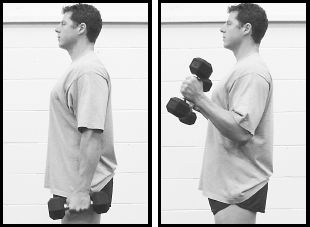
Main muscles worked
biceps, brachialis, brachioradialis, forearms
Capsule description
standing or seated, arms and forearms hanging straight, lift the weight through bending at your elbows
The curl can be done with dumbbells or a barbell, standing or seated. If done seated, use dumbbells in order to extend your forearms fully. There are also cable and machine variations of the curl.
The biceps flex the elbows and supinate the hands. To supinate your hands fully, rotate them from a palms-down to a palms-up position. You can’t do this with a barbell. The biceps isn’t the only elbow flexor. There are the brachialis (beneath the biceps) and the brachioradialis (from just above the elbow, to the wrist), too, which are also worked by the curl. The latter two muscles flex the elbow only, they don’t supinate the hand.
While permitting supination and a full range of motion even while seated, the dumbbell curl produces another advantage over the barbell curl—the ability for the wrists and elbows to adopt the most comfortable positioning.
In all curls, keep your wrists and hands in a straight line—the neutral position. If you don’t maintain the neutral position, you may develop wrist and elbow problems.
Spotting
Technique deterioration is shown through leaning back (unless you use back support) and bringing the elbows too far forward. As soon as your torso goes back even a whisker beyond the vertical, your spotter should urge you to straighten up. If you perform another rep, a little assistance may be needed if you’re to complete the rep in correct technique. Assistance should be applied with two hands, in a symmetrical way. Just enough help should be given to keep your torso and arms vertical.

The correct, straight, or neutral position of hands and wrists (top), and the incorrect position (above).

Comparison of a straight bar and an EZ-curl bar. The EZ-curl bar may be more comfortable to use for the barbell curl than a straight bar.
Sit at the end of a bench, with your knees together, and feet on the floor. Hold a dumbbell in each hand, with straight elbows, hands parallel with each other, an upright torso, and your shoulders retracted.
Curl the dumbbells, don’t swing them—move smoothly. As the dumbbells ascend, supinate your hands as much as possible—rotate your thumbs outward. On the descent, pronate your hands so that, in the starting position, they are parallel with each other once again.
Start with your elbows at your sides so that your arms are vertical when viewed from the side and from the front. As you curl, your elbows may come forward only slightly. At the top position, your hands should be several inches short of where they would be to make your forearms vertical. Your hands may come to shoulder height, but no higher.
Pause for a second in the top position. Contract your biceps hard at the top position as you fully supinate your wrists. It’s not possible to rest at the top of a properly performed curl. Lower the resistance under control, pause for a second at the bottom position, then smoothly perform the next rep. Exhale during the ascent, and inhale during the descent.

Perform the dumbbell curl with your hips, back, and shoulders against an incline bench set at about 45 degrees. For comfort, your head doesn’t have to rest against the bench. To make it easy to pick up the dumbbells from the floor, use the lowest seat setting, if it’s adjustable. And because of the incline bench, your arms may not be perfectly vertical. Otherwise, the technique is the same as for the Seated dumbbell curl.

Stand with your feet about hip-width apart. Keep your knees slightly unlocked, and your buttocks tensed, to help support your spine. Use a supinated (palms-up) grip on the barbell, with hands spaced a little wider than hip-width. Fine-tune this to find the hand spacing that’s most comfortable for your wrists and elbows. Other than there being no wrist rotation in the barbell curl, the rest of the technique is the same as for the Seated dumbbell curl.
If the straight bar irritates your elbows or wrists, try a closer or wider grip. If that doesn’t correct the problem, try the EZ-curl bar. If that doesn’t produce a comfortable curl, use dumbbells. An EZ-curl bar is a short barbell that has a number of bends or cambers in it, to enable the user to try to find the grip that feels the most comfortable.

Correct starting and finishing positions (top photos). Incorrect finishing positions (bottom photos).
Different wrist positions produce different effects on the elbow flexors, and apply stress differently to the elbow joints. One alternative is to keep your thumbs up all the time—the hammer curl. If you’ve had wrist, elbow, or shoulder problems, the hammer curl may be the variation that feels the most comfortable. The hammer curl may be performed standing (illustrated), seated at the end of a horizontal bench, or seated on an incline bench.
